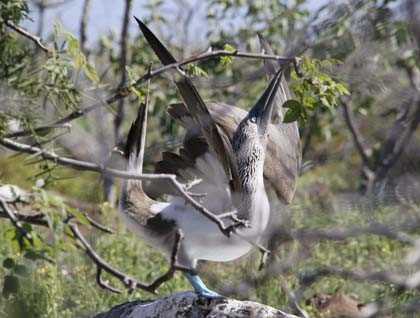Early this morning, the National Geographic Endeavour is anchored at the North Channel separating Baltra and North Seymour. After breakfast, we get ready for the day’s excursion and disembark via Zodiacs. It is a rocky landing at North Seymour Island, an exciting start for our explorers.
The day is sunny and humid and there is a nice bit of breeze. The attractions are right where we expect them. The Galápagos land iguanas are feeding on green vegetation. The blue-footed boobies are dancing close to the disembarkation area. We see frigatebirds with their red throats inflated like balloons. The birds have a little difficulty flying because the inflated balloons definitely make the birds less aerodynamic!
As we walk along the beach, the scenery is unique. The action of the island is intense and dispersed. After the coastal walk, we follow the path inland looking for an incense tree forest. There we have up-close encounters with frigatebirds, Darwin finches, and Galápagos doves, which decorate the vegetation and happily sing the songs of nature.
By ten thirty in the morning, we have covered the total length of the visitor site on North Seymour and our expectations have been exceeded. Then it’s back onboard the ship for a lecture and lunch.
The afternoon program takes place in another island of this incredible archipelago. By two in the afternoon, we are anchored off Rabida Island, the red island in Galápagos. Some of us board the glass-bottom boat and others board Zodiacs for a snorkeling adventure. The water temperature of 79°F is perfect. Along the coast, we are excited by the lively fish activity and our aquatic encounters with sharks, rays, penguins, and even marine iguanas feeding underwater.
Toward the end of our excursion, we walk along the beach of Rabida Island when the light is perfect for photography. Sea lions and ghost crabs lounge in our presence, giving photographers time for nice interpretations of the wildlife. Then it’s time to prepare for our next excursion to the youngest part of the Galápagos archipelago.







